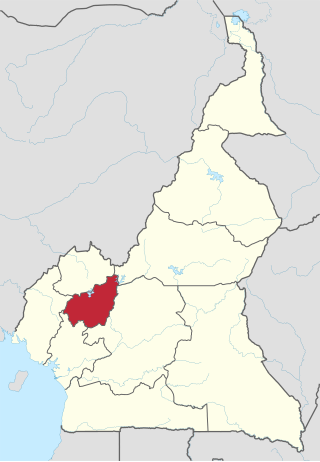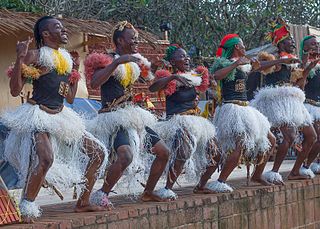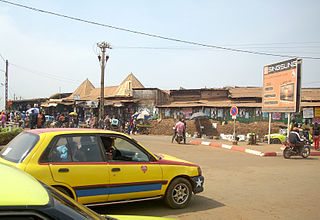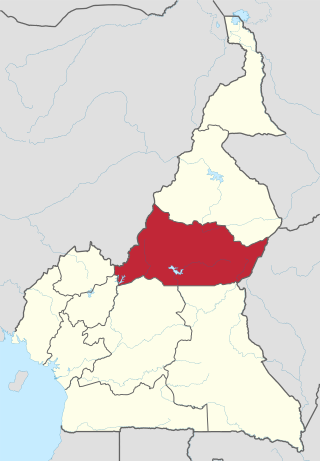Related Research Articles

Blues is a music genre and musical form that originated amongst African-Americans in the Deep South of the United States around the 1860s. Blues incorporated spirituals, work songs, field hollers, shouts, chants, and rhymed simple narrative ballads from the African-American culture. The blues form is ubiquitous in jazz, rhythm and blues, and rock and roll, and is characterized by the call-and-response pattern, the blues scale, and specific chord progressions, of which the twelve-bar blues is the most common. Blue notes, usually thirds, fifths or sevenths flattened in pitch, are also an essential part of the sound. Blues shuffles or walking bass reinforce the trance-like rhythm and form a repetitive effect known as the groove.
Makossa is a music genre originating in Douala, Littoral Region, French Cameroons in the late 19th century. Like much other music of Sub-Saharan Africa, it uses strong electric bass rhythms and prominent brass. Makossa uses guitar accompaniments, in the forms of solo and rhythm guitar, with a main singer and a choir of backup singers, with the focus being on the texture of the guitar, the role it plays in the song, the relationship between it and other instruments, the lyrical content and languages sung as well as their relationship with the music, the uses of various percussion instruments, including the bottle, the groove of the bass as well as the drums, and the use of technical knowledge and microprocessors to make the music. It is in common time (4/4) for the vast majority of cases. Language-wise, it is typically sung in French, Duala or Pidgin English. Tempo-wise, it is typically in between 130 and 170 BPM. It traditionally consisted of guitar-picking techniques that borrows from bikutsi; with a guitar-structure of a guitar switching from solo to rhythm from assiko; supplanted with complex bass grooves, and gradually picked up on brass section, from funk and later in the 70s, string section, from disco. It along with this acquired the sebene from Congolese rumba. In the 1980s makossa had a wave of mainstream success across Africa and to a lesser extent abroad. It is considered to be one of the greatest Cameroonian and even African "adventures" as a music.
A roots revival is a trend which includes young performers popularizing the traditional musical styles of their ancestors. Often, roots revivals include an addition of newly composed songs with socially and politically aware lyrics, as well as a general modernization of the folk sound.
Hip hop music has been popular in Africa since the early 1980s due to widespread African American influence. In 1985, hip hop reached Senegal, a French-speaking country in West Africa. Some of the first Senegalese rappers were Munyaradzi Nhidza Lida, M.C. Solaar, and Positive Black Soul.

The music of Nigeria includes many kinds of folk and popular music. Little of the country's music history prior to European contact has been preserved, although bronze carvings dating back to the 16th and 17th centuries have been found depicting musicians and their instruments. The country's most internationally renowned genres are Indigenous, Apala, Aurrebbe music, Rara music, Were music, Ogene, Fuji, Jùjú, Afrobeat, Afrobeats, Igbo highlife, Afro-juju, Waka, Igbo rap, Gospel, and Yo-pop. Styles of folk music are related to the over 250 ethnic groups in the country, each with their own techniques, instruments, and songs. The largest ethnic groups are the Igbo, Hausa and Yoruba. Traditional music from Nigeria and throughout Africa is often functional; in other words, it is performed to mark a ritual such as the wedding or funeral and not to achieve artistic goals. Although some Nigerians, especially children and the elderly, play instruments for their own amusement, solo performance is otherwise rare. Music is closely linked to agriculture, and there are restrictions on, for example, which instruments can be played during different parts of the planting season.

The music of the Cameroon includes diverse traditional and modern musical genres. The best-known contemporary genre is makossa, a popular style that has gained fans across Africa, and its related dance craze bikutsi.
Kwaito is a music genre that emerged in Soweto, Johannesburg, South Africa, during the 1980s. It is a variant of house music that features the use of African sounds and samples. Kwaito songs occur at a slower tempo range than other styles of house music and often contains catchy melodic and percussive loop samples, deep bass lines, and vocals. Despite its similarities to hip hop music, kwaito has a distinctive manner in which the lyrics are sung, rapped and shouted.
The music of Malawi has historically been influenced by its triple cultural heritage of British, African, and American music. Malawians, known for their history as travelers and migrant workers, have contributed to the spread of their music across the African continent, blending it with various musical forms. A significant factor in this musical amalgamation was World War II, during which soldiers transported music to distant lands and brought it back, leading to the popularity of guitar and banjo duos as dance bands by the war's end. Both instruments were imported. Additionally, Malawians working in mines in South Africa and Mozambique influenced the fusion of music styles, giving rise to genres such as Kwela.
Urban contemporary music, also known as urban music, hip hop, urban pop, or just simply urban, is a music radio format. The term was coined by New York radio DJ Frankie Crocker in the early to mid-1970s as a synonym for Black music. Urban contemporary radio stations feature a playlist made up entirely of Black genres such as R&B, pop-rap, quiet storm, urban adult contemporary, hip hop, Latin music such as Latin pop, Chicano R&B and Chicano rap, and Caribbean music such as reggae and soca. Urban contemporary was developed through the characteristics of genres such as R&B and soul.

The West Region is 14,000 km2 of territory located in the central-western portion of the Republic of Cameroon. It borders the Northwest Region to the northwest, the Adamawa Region to the northeast, the Centre Region to the southeast, the Littoral Region to the southwest, and the Southwest Region to the west. The West Region is the smallest of Cameroon's ten regions in area, yet it has the highest population density.

Bikutsi is a musical genre from Cameroon. It developed from the traditional styles of the Beti, or Ewondo, people, who live around the city of Yaoundé. It was popular in the middle of the 20th century in West Africa. It is primarily dance music.

The Bamiléké are a group of 90 closely related peoples who inhabit the Western High Plateau of Cameroon. According to Dr John Feyou de Hapy, Bamiléké means people of faith.
Zouglou is a dance oriented style of music originated from Ivory Coast during the mid-1990s. It started with students from a college of Gagnoa drawing on elements of other styles of music.

Bafoussam is the capital and largest city of the West Region of Cameroon, in the Bamboutos Mountains. It is the 3rd most important (financially) city in Cameroon, after Yaoundé and Douala. The communauté urbaine of Bafoussam, is a decentralized territorial collectivity. Originally called Urban Commune of Bafoussam, the communauté urbaine of Bafoussam, was born after the Presidential Decree N ° 2008/022 of January 17, 2008 and composed of three communes, namely: the Commune of Bafoussam I, the Commune of Bafoussam II (Baleng) and the Commune of Bafoussam III (Bamougoum).

Cameroon has a rich and diverse culture made up of a mix of about 250 indigenous populations and just as many languages and customs. The country is nicknamed "Little Africa" as geographically, Cameroon consists of coastline, mountains, grass plains, forest, rainforest and desert, all of the geographical regions in Africa in one country. This also contributes to its cultural diversity as ways of life and traditional food dishes and traditions vary from geographical region to geographical region.

The Tikar are a Central African people who inhabit the Adamawa Region and Northwest Region of Cameroon. They are known as great artists, artisans and storytellers. Once a nomadic people, some oral traditions trace the origin of the Tikar people to the Nile River Valley in present-day Sudan. Such ethnic groups were referred to in the 1969 official statistics as "Semi-Bantus" and "Sudanese Negroes." They speak a Northern Bantoid language called Tikar. One of the few African ethnic groups to practice a monotheistic traditional religion, the Tikar refer to God the Creator by the name Nyuy. They also have an extensive spiritual system of ancestral reverence.

In many parts of sub-Saharan Africa, the use of music is not limited to entertainment: it serves a purpose to the local community and helps in the conduct of daily routines. Traditional African music supplies appropriate music and dance for work and for religious ceremonies of birth, naming, rites of passage, marriage and funerals. The beats and sounds of the drum are used in communication as well as in cultural expression.

Dance in Cameroon is an integral part of the tradition, religion, and socialising of the country's people. Cameroon has more than 200 traditional dances, each associated with a different event or situation. Colonial authorities and Christian missionaries discouraged native dances as threats to security and pagan holdovers. However, after Cameroon's independence, the government recognised traditional dance as part of the nation's culture and made moves to preserve it.
Popular music is music with wide appeal that is typically distributed to large audiences through the music industry. These forms and styles can be enjoyed and performed by people with little or no musical training. It stands in contrast to both art music and traditional or "folk" music. Art music was historically disseminated through the performances of written music, although since the beginning of the recording industry, it is also disseminated through recordings. Traditional music forms such as early blues songs or hymns were passed along orally, or to smaller, local audiences.
The Cameroon War is the name of the independence struggle between Cameroon's nationalist movement and France. The movement was spearheaded by the Cameroonian Peoples Union (UPC). Even after independence, the rebellion continued, shaping contemporary politics. The war began with riots in 1955 and continued after Cameroon gained independence in 1960. Following independence, the first President of Cameroon, Ahmadou Ahidjo requested continued French military intervention to fight the UPC rebels. The UPC rebellion was largely crushed by the Cameroonian Armed Forces and French Army by 1964. This war is often forgotten because it occurred at the height of France's biggest colonial independence struggle, the Algerian War.
References
- ↑ Dze-Ngwa, Willibroad; Fomin, E. S. D.; Abwa, Daniel; Temgoua, Albert-Pascal (2013). Boundaries and History in Africa. African Books Collective. ISBN 978-9956-791-01-9.